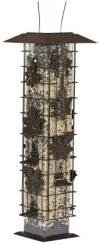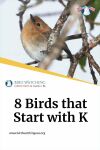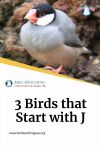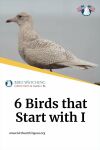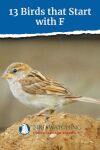
Introduction
All bird lovers, gather here! What crosses your mind when you think of birds and the letter F? Maybe you picture a feather, but for us, it’s a list of the most common birds in the USA and Canada - that start with the letter F. And did you know that there are only 13 out of 750 of such birds? At around only 1.7%, these birds aren’t that much but you’ll find some fascinating crows, owls, hawks and sparrows on the list.
First of all, I would like to thank the folks at EBirds, whose data made this list possible. Thanks to their precise percentages, I was able to arrange the list in descending order. EBirds is a platform for bird lovers like us to join heads and contribute as much information related to our feathered friends as possible.
So let’s look at the brief list first.
| Fish Crow | 4.62% |
|---|---|
| Field Sparrow | 4.16% |
| Forster’s Tern | 2.19% |
| Fox Sparrow | 2.13% |
| Franklin’s Gull | 0.49% |
| Ferruginous Hawk | 0.22% |
| Fulvous Whistling-Duck | 0.10% |
| Florida Scrub-Jay | 0.06% |
| Fork-tailed Storm-Petrel | 0.02% |
| Flammulated Owl | 0.02% |
| Fork-tailed Flycatcher | 0.01% |
| Five-striped Sparrow | 0.01% |
| Ferruginous Pygmy Owl | 0.01% |
But I really recommend that you go through the details of each bird. I’ve included some mesmerizing photos that’ll leave you speechless for sure. Don’t forget to check out my personal favorite at #7!
1. Fish Crow
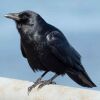
Clearly a winner, we have the Fish Crow at #1! A good way to spot them is along with American crows. But your best bet is to head over to lakes and oceans, where you can see these lovely crows in flocks!
During courtship, both the male and female crow glide close together, displaying romance in mid-air. Did you know that they build a new nest every time they breed? But you can also find them in the nests of other birds, and often steal their food too!
Look for their nest in a straight and tree or thick shrub. The nest can be as low as 5 feet or as high as 70 feet above the ground. So get ready to bend your neck!
Also, did you know that they stash away their nice food in well-hidden places beneath the grass or inside the barks of trees. Since they’re omnivorous birds, they can feed on literally anything. So you can expect to find them eating seeds, berries, nuts, and animals such as crabs. They also feed on the eggs of many animals, turtle eggs and bird eggs are among the top in their diet!
fun fact
the oldest fish crow recorded
14 years and 6 months is the oldest lifespan recorded for the fish crow.
2. Field Sparrow
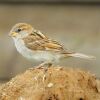
The cute little Field Sparrow comes in at #2! With their bouncy tails, they make quite the rustling noise while moving through thick bushes and fields. It’s easy to spot these birds on the roadside, particularly in the Midwestern and Eastern regions. Keep your ears open to their soft notes that are all almost of the same pitch. Another tip: Their song ends with a trilling sound at the end!
Within a season, they can breed more than one time. Each time that they breed, they build a new nest and go higher than the last time. And since they are small and barely aggressive, they usually join flocks of other birds during the winter. Song sparrows are one such example.
The field sparrow is easily attracted to birdfeeders, so why not have a feeder like this in your backyard?
Perky-Pet 336 Squirrel-Be-Gone Wild Bird Feeder
This cage is made completely of metal, along with ports that close off to resist squirrels from eating bird food. Holds up to 2 pounds of feed, and comes with 6 feeding ports.
did you know?
Their nests are often invaded!
You can find eggs of brown-headed cowbirds as field sparrows are parasitic to these birds. Around 50 to 80% of field sparrow nests in Iowa and Illinois were found with the eggs of brown-headed cowbirds.
3. Forster’s Tern
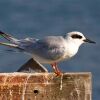
Look who comes in at #3, it’s the Forster’s Tern! They don’t dive deep into the waters and only cruise in a shallow manner, which makes it easy to spot them. And it makes sense because they love to forage by hovering over the surface of the water.
You can look for their nests too, but they’re very protective of them so be careful! You can find their nests on top of thick vegetation to even on top of thick plants. Both the parents incubate the eggs, that are olive to buff in color, sometimes with a range of brown spots. You can expect to see as many as 4 eggs at once.
In summer, these birds love to feed on insects in marshes. They’ll also keep their eyes out to lunch for small frogs in any body of water, although they are more accustomed to eating fish. In the winter as well, you can find this bird on the coasts besides oceans and on land in the Southeast. You’re more likely to find them hanging around places that are bodies of water and mud such as marshes and bays.
If you want to search for them by sound, their calls sound like nasal beeps!
fun fact
stuffing of Forster's tern
Many Foster's Terns were stuffed to be used as accessories on large hats. However, this stopped when the Migratory Birds Acts were passed. Namely the Migratory Birds Convention Act (1917) in Canada and the Migratory Bird Treaty Act (1919) in the United States.
4. Fox Sparrow
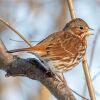
Up next we have the Fox Sparrow at #4! You can hear the male fox sparrow singing to defend its nesting territory during Spring.
If you have vegetation in your backyard and it’s growing in full swing, you might spot a fox sparrow foraging on the ground. They tend to go through bushes of berries and shrubs as well. On the ground, they’re scratching for seeds that may have been buried deep in the vegetation growing. They forage the ground and scratch through the soil and snow to find insects and seeds. They use both their feet to do the scratching, accompanied with a bit of forward jumping that looks like an excited movement. In coastal areas, they feast on tiny marine life too. It mostly eats insects during breeding season. For all the other seasons, the diet is made up of mostly seeds.
The nest is most probably built by the female and is typically 8 feet above the ground. Although the location is roughly close to the ground, the shrub they choose is usually thick and dense. So if you’re trying to spot the nest of a Fox Sparrow, you’ll have to look super close!
You can also pay attention to its cheerful song! It begins with a couple or three whistles, followed by trilling or churring.
did you know?
Fossils of fox sparrows
Fossils of fox sparrows that date back to as much as 11,000 years have been found in California at the La Brea tar pits and also in Pennsylvania and Virginia.
5. Franklin’s Gull
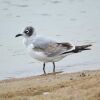
The Franklin’s Gull is no ordinary seabird and it’s the 5th most common one on our list! It sounds similar to the Laughing Gull and you would immediately recognize the high-pitched, hysterical ‘ha-ha-ha’. In the winter, you’ll find them along the coasts of Chile and Peru.
You can spot these birds foraging on the ground, by either wading or walking. But if they see flying insects, they don’t hesitate to catch them mid-air!
In courtship, both the birds stand together, often moving their heads towards each other and then away from them. They steal nest material from other nests and you can find their nests on marshes that have water several feet deep. Both the male and the female bird participate in nest-building. You can find thousands of them nesting in the marshes of North America. Their nesting is style is rather peculiar. Since their nest floats, it eventually sinks soon as the holding material decays! While breeding, you can even see a tinge of rosy pink across its abdomen and chest. However, the color fades away as the season goes away. Catch these
did you know?
the oldest recorded franklin's gull
The oldest age recorded was 9 years, 5 months old. But it didn't have a natural death, as it was shot to death in Montana in 1972.
6. Ferruginous Hawk
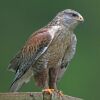
So we have a hawk on #6! The Ferruginous Hawk are quite easy to come across in the open country side.
If you find the Ferruginous Hawk in pairs, they’re most likely circling their nesting territory. It’s wonderful to watch and I have experienced them defending their nest firsthand. They usually build their nest on the top of a tree, which is at least 20 feet above the ground but it can go as high as 50 feet too.
But your best bet to spot the Ferruginous Hawk is when it is flying. That’s because they usually hunt their prey while soaring high up in the sky. But that’s not always the case, though! When I spotted this hawk, it was on the ground, standing still and most likely waiting for rodent to prey on! They’re quite fond of mice, you know. But they’ll also make larger targets such as squirrels and snakes.
I know it could get hard to spot these clever creatures while they’re flying. So pay attention to the call of the Ferruginous Hawk instead. Since it is fairly loud, so you can catch its ‘kree-e-ah’ voice quite clearly!
fun fact
feathered legs
The Ferruginous Hawk is one of the only two American hawk species to have feathers on their legs and toes. The other one is the Golden Eagle and both of these birds have rough legs!
7. Fulvous Whistling-Duck
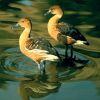
On lucky number 7, we have the Fulvous Whistling-Duck! These brown-feathered ducks are excellent swimmers! Even their young ones excel at diving and searching for their own food.
These ducks are 95% vegetarian. When I first came across them, they were dabbling at the surface of the water. So I took it that they love irrigated land and staying close to marshes or other places where shallow water is close by. If by any chance, they don’t have plants to feed on, they’ll prey on aquatic insects instead!
Another awesome fact is that these birds have more swan-like instincts rather than those of ducks. Once the male and female mate, they remain bonded for a lifetime. The male even helps take care of the young ones - a tendency that is common among swans!
And of course, the name says it all! Keep your ears active for a call that sounds like a coarse ‘ka-weee’ whistle.
fun fact
Rice fields in the usa
Want to spot many fulvous whistling-ducks? Guess what? Rice fields are one of their most popular hangout spots in the United States! In Central Florida, they are in these fields all through the year. While from Spring to Fall, you can find them along the coasts of Louisiana and Texas.
8. Florida Scrub-Jay
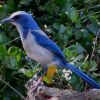
Dear birdwatcher, if you live in Florida, you’re in luck! If not, you’ll have to plan a vacation then! Because on #8 we have the Florida Scrub-Jay!
Since these birds don’t migrate much, your best bet would be to visit a bird reserve in Florida. They mostly live in patches int he areas where there is sand. I had the opportunity to see these birds in flocks when I was on vacation. I saw them moving across the ground and in trees to search for acorns.
But that wasn’t even the fun part. The actual deal was how they were burying the found acorns deep into the sand. Yes, these birds come back to retrieve their goodies like buried treasure. Although arthropods and acorns are their favorite in all the seasons, you’ll find them preying on reptiles, rodents, eggs, and young ones of smaller birds, and even insects as small as snails and spiders.
As for their sound, they’re either shreeping or trilling.
PRO-TIP
florida scrub-jays are defensive
The entire community joins in to offer protection against a predator!
9. Fork-tailed Storm-Petrel
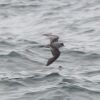
At #9, we have an amazing seabird known as Fork-tailed Storm-Petrel! You can see its silvery-bluish body hovering around from miles away, but you can’t find it everywhere.
You can go through Alaska to Northern California to see this wonderful bird on your own! The Pacific Ocean is a favorite spot for these birds, where you can find them in flocks. They are really fond of deep waters, and I’ll never forget their flight over the surface of the Pacific Ocean! The best time to watch this seabird is the same as that of others - from the early morning hours to the late afternoon.
I personally watched them foraging the surface of the water for food. Then, of course, most of their diet is made up of fish and crustaceans. You can also watch it perform a very cool dive into the water while hovering down to the sea.
And if you want some tips for the voice, pay attention to twitters and squeaks. Although, they are most likely to call while being around their nests. Also, they nest only in colonies on islands, their active time around their nests is all through the night!
fun fact
store oil in their stomachs
The fork-tailed Storm-Petrel stores oil in its stomach. It then uses this oil to feed its chick. And wait till you hear more. The chicks, if not fed for days, lower their body temperature and can survive without food not given due to bad weather!
10. Flammulated Owl
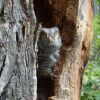
Guess what? We have the Flammulated Owl on #10! Although they’re fond of making their homes in cavities of trees, why not try setting up a nest box in your backyard?
Just like any other owl that’s nocturnal, the flammulated owl is mostly active at dawn and when it immediately gets dark. You won’t find them in the hovering around or hunting in the middle of the night. So why not get up like I did and go on a birdwatching hunt for the wonderful flammulated owl?
As for diet, they are a huge insect lover. They mostly target large ones such as moths and crickets. I spotted one of them eating a beetle once and after catching it with its feet from foliage! I was also able to discover it thanks to its repetitive low hoots. But the low hooting can also be quite confusing, so do keep a flashlight and don’t remain too long in the environment to avoid disturbing the owl!
fun fact
found lesser in northern areas
When winter arrives in the Northern areas, insects become scarce. And so do flammulated owls, since insects make up their primary diet! So they don't stay there in the winter season, otherwise, they'd starve to death!
11. Fork-tailed Flycatcher
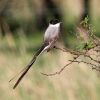
At #11 we have the Fork-tailed Flycatcher! A lot of fork-tailed flycatcher birds in South America are known to migrate. So if you’re able to spot a fork-tailed flycatcher, chances are they most probably made a migratory mistake! You can also find plenty of them in Central America and Mexico, but North America is your best bet.Head over to the Atlantic coast, that too in the Fall season. You can also go to the countryside, as these flycatchers love to perch on wires and fences. They’re a huge fan of sitting in bushes and trees, so don’t forget to look closely!
fun fact
the shape of their tail
When in flight, the fork-tailed flycatcher's tail resembles a ribbon that's shaped like a lyre.
12. Five-striped Sparrow
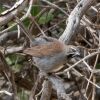
We have this cute sparrow at #12. Now let’s talk about what makes the five-striped sparrow so unique.
I found this five-striped sparrow foraging on the ground in my backyard. Could I get any luckier than that? I saw three of them moving around slowly and since my outdoor space has plenty of vegetation, they were attracted to them. They feast on vegetables and even on tiny insects, so backyards are a good place for their hunting sprees. They’re like an all-you-can-eat buffet for these cute sparrows.
It song doesn’t stay the same. So you may find many variations but I could relate its voice to that of the black-throated sparrow!
fun fact
a rare breeding species
In the Continental United States, the five-striped sparrow is the rarest breeding species among sparrows. You can only find them in the farthest South regions of Arizona.
13. Ferruginous Pygmy-Owl
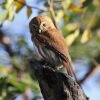
And so, at #13 we have the Ferruginous Pygmy Owl! The most common places to find this cute brown-feathered owl is in Arizona and the South of Texas.
Just like any other owl, you can find the Ferruginous Pygmy-Owl hunting in the early morning hours or at dusk. But you can find them hunting during the day as well, sometimes while singing a song. I myself spotted one mid-day while it was perching on a tree, all ready to hunt as soon as it sees prey. The diet of this fascinating owl includes a variety of reptiles like lizards and rodents like mice. They even feast on other birds and a variety of insects and small mammals!
As for their calls, listen if you can find any sort of repeated whistling that sounds monotonous, along with rigid hoip sounds. You can also find the male whistling while trying to defend their nesting territory. They sometimes make calls during the day as well!
pro-tip
look for white streaks
The Ferruginous Pygmy-Owl can be in a variety of colors. Apart from brown, you can also find one with rust gray feathers. But the most common feature amongst all these owls is the series of white streaks on its head!
Conclusion
So there you go! That ends our list of the 13 most common birds in the USA and Canada that start with F. Have you seen any of the above previously on your birdwatching trips? Even if you haven’t, now is the best time to follow all the birdwatching tips I have given you. Let me know what you think and if you want to learn more about most common birds that start with the letter G, here’s the complete list !
20 Birds that Start with G
Did you know that out of the 750 most common birds in the USA and Canada, there are 20 birds that start with the letter G? Here's the complete list!

By David A. Swanson
Bird Watching USA
My name is David and I'm the the founder of Bird Watching USA! I started Bird Watching with My father-in-law many years ago, and I've become an addict to watching these beautiful creatures. I've learnt so much over about bird watching over the years that I want to share with the world everything I know about them!

David A. Swanson
Bird Watching USA
My name is David and I'm the the founder of Bird Watching USA! I started Bird Watching with My father-in-law many years ago, and I've become an addict to watching these beautiful creatures. I've learnt so much over about bird watching over the years that I want to share with the world everything I know about them!

